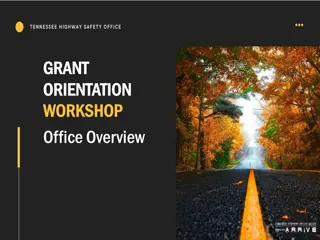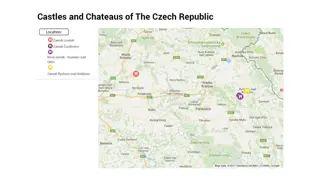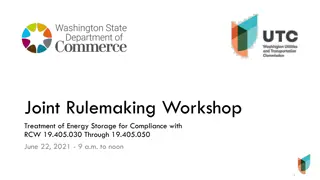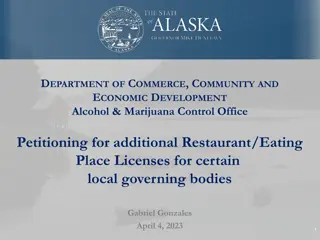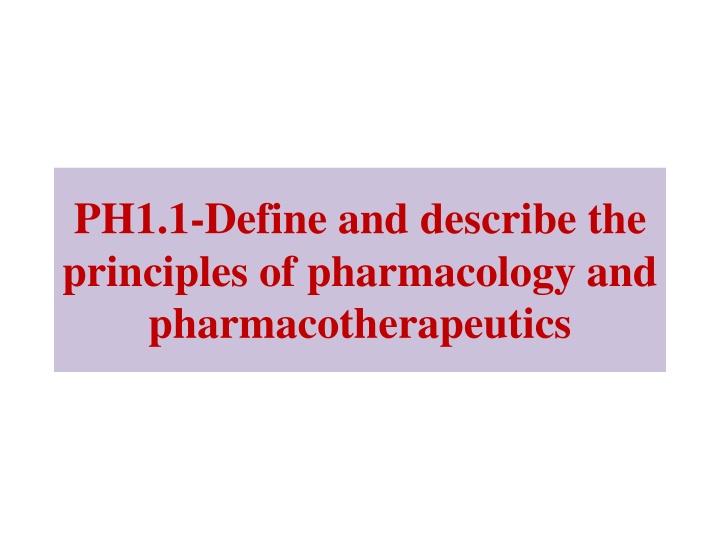
Principles of Pharmacology and Pharmacotherapeutics
Explore the fundamentals of pharmacology and pharmacotherapeutics, including the definition of drugs, the contributions of pharmacologists in patient care, and the broad areas of pharmacology such as pharmacokinetics and pharmacodynamics. Learn about the origins of pharmacology and key figures in the field like Oswald Schmiedeberg and Sir Ram Nath Chopra. Discover how drugs alter the body's state and the various sources of drugs as well as therapeutic goals that can be achieved through drug use.
Download Presentation

Please find below an Image/Link to download the presentation.
The content on the website is provided AS IS for your information and personal use only. It may not be sold, licensed, or shared on other websites without obtaining consent from the author. If you encounter any issues during the download, it is possible that the publisher has removed the file from their server.
You are allowed to download the files provided on this website for personal or commercial use, subject to the condition that they are used lawfully. All files are the property of their respective owners.
The content on the website is provided AS IS for your information and personal use only. It may not be sold, licensed, or shared on other websites without obtaining consent from the author.
E N D
Presentation Transcript
PH1.1-Define and describe the principles of pharmacology and pharmacotherapeutics
Specific learning objectives (SLOs) At the end of the teaching learning session, the M.B.B.S Phase II student shall be able to Develop positive attitude towards pharmacology Define various terms and branches of pharmacology Enumerate sources of drugs Enumerate various therapeutic goals that can be achieved by drug use Be aware of contribution a pharmacologist can give in patient care
Pharmacology Derived from two Greek words o Pharmakon= Active principle/active ingredient or equal to drug, medicine or poison and.. o Logos=study ( a discourse or treatise) It is the science that deals with the study of drugs and their interaction with the living system
Pharmacology Oswald Schmiedeberg - Father of Pharmacology, conducted extensive research on drugs Sir Ram Nath Chopra-Father of Indian Pharmacology; Doyen of science ad medicine Francois Megendie and Claude Bernard- use of animal experiments to understand effect of drugs
Drug A French word Drogue which means dry herb. Defined as any substance used for the purpose of diagnosis, prevention, relief or cure of a disease in man or animals. According to WHO, A drug is any substance or product that is used or intended to be used to modify or explore physiological systems or pathological states for the benefit of the recipient .
Drug Alters state of body: can t create new function but alter existing function. The actions may be beneficial or harmful. Drugs are poisons if used irrationally.
Broad areas of Pharmacology Pharmacokinetics: deals with absorption, distribution, metabolism and excretion of drugs (what body does to drug). Pharmacodynamics: quantitative study of effects of drugs including site and mechanism of action(what the drug does to the body).
Broad areas of Pharmacology Dosing regimen Absorption Distribution Metabolism Elimination Pharmacokinetics Conc. In plasma Conc. at site of action Action Pharmacodynamics Effects observed
Broad areas of Pharmacology Pharmacotherapeutics: use of drugs in prevention and treatment of diseases. Toxicology: science of poisons. Chemotherapy: effect of drugs upon microorganisms, parasites and neoplastic cells living and multiplying in Iiving organisms (cancer treatment). Pharmacoepidemiology: use and effect of drugs in large number of people.
Broad areas of Pharmacology Pharmacoeconomics: analysis of the cost of drug therapy and its benefits to the society Pharmacovigilance:detection,assessment, understanding and prevention of adverse effects or any other drug related problem Pharmacogenetics: genetic basis for variations in drug metabolism and response to humans. Pharmacogenomics: genomic variability to assess its effects on the drug response of humans.
Broad areas of Pharmacology Pharmacometrics: quantitative relationship between exposure to the drug (PK) and its response (PD) Essential medicines: those drugs that satisfy the healthcare needs of majority of population and should be available all time in adequate amounts and in appropriate dosage forms. Orphan drugs: drugs used for prevention and treatment of rare diseases. Pharmacopoeia: the official publication containing information about drugs.
Broad areas of Pharmacology Chrono pharmacology: correlation of drug effects to the circadium rhythm to obtain optimum therapeutic effects and minimal adverse effects. e.g bronchospasm usually occurs at night. BP rises at dawn and dusk and minimal at midnight. Chronotherapy: Administration of drugs to match the circadian rhythm Chronobiotics: drugs that used to modify or meet the circadium rhythm.
Nature and sources of drugs (for SDL) According to sources they are: 1. Natural drugs A. Plants: Digoxin from Digitalis purpurea, Atropine from Atropa belladonna B. Animals: Insulin from pork/beef, cod liver oil from cod liver fish C. Minerals: Iron, iodine, potassium salts etc D. Microorganisms: Penicillin from penicillium notatum, Chloramphenicol from Streptomyces venezuelae
Nature and sources of drugs 2.Synthetic drugs: prepared by chemical synthesis in pharmaceutical laboratories. e.g Sulphonamides, quinolones, barbiturates. 3.Semi-synthetic drugs: prepared by chemical modification of natural drugs. E.g Ampicillin from penicillin G, Dihydroergometrine from ergometrine. 4.Biosynthetic drugs: prepared by cloning of human DNA in to the bacteria like E. Coli e.g Human insulin ( Humulin), human GH.
Drug compendia Sources of drug information (Sources of drug information) Pharmacopoeia: an official code containing selected list of established drugs and medicinal preparations with descriptions of their physical/chemical property and tests for their identity, purity, average adult doses and potency of official approved drugs in a country. They are useful to drug manufacturers and regulatory authorities. E.g the Indian Pharmacopoeia (IP), the British Pharmacopoeia(BP), the United States Pharmacopoeia(USP), European Pharmacopoeia Legal aspect from the point of view of drug regulatory authority.
Drug compendia Formularies: not a regulatory document provides information about the available drugs . Indications, contraindications, dosage , precautions, adverse effects based on original and reputed drug information sources and experts recommendation. Provides up-to-date guidance to prescribers. E.g. the National formulary of India, the British national formulary.
Drug compendia Martindale: (Non official compendium) The Complete Drug Reference (Extrapharmacopoeia) is a compendium, which provides unbiased information about drugs and medicines and medicines with references. Including trade names and manufacturer s contact information. Includes new upcoming drug in market and contains pharmacological and therapeutic information about the new drug.
Drug compendia The Physician s drug reference (PDR) or the Indian drug review (IDR) or the Monthly index of Medical specialities (MIMS) or the Current index of Medical specialities (CIMS) Information about brands, formulations, strength, cost, dose, precautions, adverse effects, contraindications are available Useful non-official compendia.
PH1.9-Describe nomenclature of drugs i.e. generic, branded drugs
SLOs Should be able to- Describe different nomenclature of drugs Differentiate generic vs branded drugs Identify generic and branded drugs Discuss LASA and Poor quality drugs
Drug nomenclature A drug has at least three types of names: Chemical name or scientific name Generic/International nonproprietary name Proprietary/trademark/Brand name
Drug nomenclature Chemical name or scientific name: based on molecular structure of the drug, very long, too complex to use in common practice. Generic/International nonproprietary name: given by competent scientific body, WHO, which is internationally accepted. Recommended in Rx, cheaper, economical, usually same all over the world. Proprietary/trademark/Brand name: given by pharmaceutical company, costly, one drug can have many brand names.
Drug nomenclature E.g Chemical name: Acetaminophen N-(4hydroxyphenyl)acetamide Generic name: Paracetamol Brand name: Calpol / Crocin
LASA drugs Look alike sound alike (LASA)drugs involve medications that are visually similar in physical appearance or packaging and names of medicines that have spelling similarities and/or similar phonetics. Threat to patient safety. e.g amiloride/amlodipine Hydralazine/hydoxyzine chlorpromazine/chlorpropamide clobazam/clonazepam Tramadol/trazodone etc.
SSFFC drugs Poor quality drugs- Substandard/spurious/falsely labelled/falsified/counterfeit (SSFFC) drugs pose serious health problem to consumers. WHO defines SSFFC drugs as- medicines which are deliberately and fraudulently mislabeled with respect to identity or source, may include products with correct or wrong ingredients or without active ingredients, with insufficient or too much active ingredients or with fake packaging.

